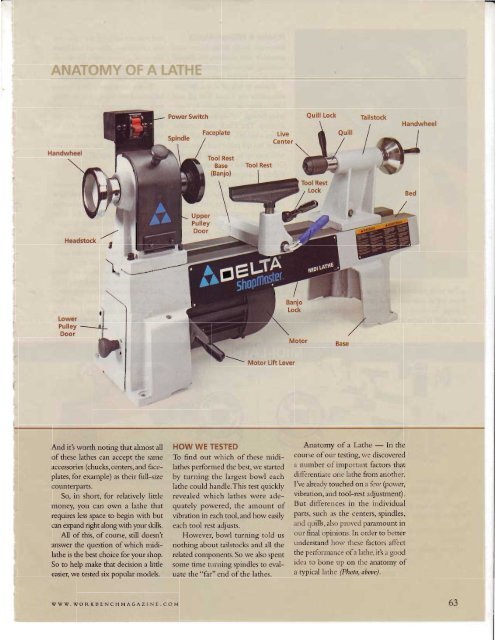You also want an ePaper? Increase the reach of your titles
YUMPU automatically turns print PDFs into web optimized ePapers that Google loves.
Power Switch Quill Lock TailstockHandwheelFaceplateTool RestBase(Banjo)\ , HandwheelLivetQuill I ILS_G_ ;Tool RestHeadstocktUpperPulleyDoorI\BaseMotor Lift LeverAnd it's worth noting that almost allof these lathes can accept the sameaccessories (chucks, centers, and faceplates,for example) as their full-sizecounterparts.So, in short, for relatively littlemoney, you can own a lathe thatrequires less space to begin with butcan expand right along with your skills.All of this. of course. still doesntanswer the question of which midilatheis the best choice for your shop.So to help make that decision a litdeeasier, we tested six popular models.HOW WE TESTEDTo find out which of these midilathesperformed the best, we startedby turning the largest bowl eachlathe could handle.This test quicklyrevealed which lathes were adequatelypowered, the amount ofvibration in each tool, and how easilyeach tool rest adjusts.Flowever, bowl turning told usnothing about tailstocks and all therelated components. So we also spentsome time turning spindles to evaluatethe "far" end ofthe lathes.Anatomy of a Lathe - In thecourse of our testing, we discovereda number of important factors thatdifferentiate one lathe from another.I've already touched on a few (power,vibration, and tool-rest adj ustment).But differences in the individualparts, such as the centers, spindles,and quills, also proved paramount inour final opinions. In order to betterunderstand how these factors affectthe performance of a lathe, it's a goodidea to bone up on the anatomy ofa rypical lathe (Photo, above).WWW.WORKBENCHMAGAZINE. COM 63











![Til]tl](https://img.yumpu.com/45878240/1/190x245/tiltl.jpg?quality=85)




